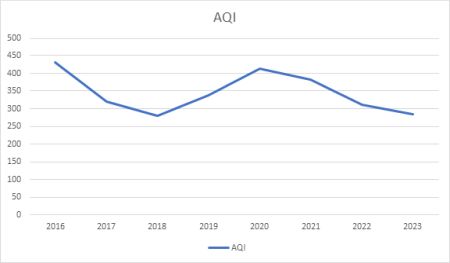Diwali, the festival of lights, is a joyous occasion celebrated with enthusiasm across India. However, the exuberance of the festival comes at a cost – a significant spike in air pollution levels. It has been observed that areas specifically in Delhi reel under the envelope of Smog post Diwali. This smog engulfs the city leading to difficulty in breathing, wheezing, coughing and allergies in eyes, etc. for the residents.
The aftermath of Diwali celebrations often sees a spike in hospital admissions due to respiratory issues. Cases of bronchitis, asthma attacks, and other respiratory ailments soar during this period. The long-term exposure to high levels of air pollution can have chronic health impacts, contributing to cardiovascular diseases and other systemic health issues.
While it is not a question whether fireworks during Diwali, which had become a tradition, have environmental and health consequences, yet one must ponder whether the bursting of firecrackers have so much smoke and potency leading to enveloping of the entire capital region?
A closer look at the Air Quality Index for the month of October is helpful to explain the issue of Air Pollution in Delhi during this time:1*

The Hidden Cause: Punjab Preservation of Sub Soil Act, 2009
There are various reasons for the degradation of air quality in the capital city such as industrial pollution, vehicular emissions, construction based activities which impact the Air Quality Index immensely. However, none of the above mentioned factors have the potential to engulf the whole metropolitan area in a cover of smog.
1. The primary reason for the enveloping of the metropolitan is the unsustainable practice of stubble burning, encouraged by the Punjab Preservation of Sub Soil Act, 2009.
2. The combustion of crop residues releases a myriad of pollutants into the atmosphere. Particulate matter, carbon monoxide, volatile organic compounds, and other harmful substances are among the emissions resulting from stubble burning.
3. The pollutants can travel over long distances, propelled by wind patterns, and settle in the air over Delhi, exacerbating the already precarious air quality in the region.
4. The timing of stubble burning, coinciding with the onset of winter and unfavourable meteorological conditions, worsens the impact. Due to temperature inversions during this period, trapping pollutants close to the ground increases the concentration of pollutants, leading to a sharp decline in air quality.
Impact of Air Pollution
The contribution of stubble burning to the formation of a thick layer of smog over Delhi is particularly noticeable. Smog, a combination of smoke and fog, reduces visibility, disrupts transportation, and poses serious health risks. The fine particulate matter released during stubble burning, especially PM2.5 and PM10, can penetrate deep into the respiratory system, causing respiratory ailments and aggravating existing health conditions.
The health consequences of this phenomenon are severe. Respiratory issues, such as asthma and bronchitis, become more prevalent, and there is a notable increase in hospital admissions during this period. Vulnerable populations, including children and the elderly, are at heightened risk of developing health complications due to prolonged exposure to polluted air.
The surge in pollutants leads to a rapid increase in the concentration of PM2.5 and PM10, fine particulate matter that can penetrate deep into the respiratory system. These elevated levels pose a direct threat to respiratory health, especially for individuals with pre-existing conditions such as asthma or chronic obstructive pulmonary disease (COPD). The elderly and children are particularly vulnerable to the adverse effects of deteriorating air quality.
Cognizance by Supreme Court of India
The Hon'ble Supreme Court of India was approached by the legendary green lawyer M.C. Mehta regarding the impact of severe Air Pollution on the general public in M.C. Mehta vs Union of India (Writ Petition(s) (Civil) No(s). 13029/1985)
The Supreme Court expressed its concerns regarding the Punjab Preservation of Subsoil Water Act, 2009 accepting that the said Act is primarily responsible for the stubble burning which is causing the hazardous air quality in the national capital. Supreme Court held that:
"Insofar as the immediate action is required, the Punjab Preservation of Subsoil Water Act, 2009 has been brought to our notice. No doubt, the objective of that Act is to preserve the subsoil water but there are ramifications on pollution also arising from the violation of the provisions of that Act because if the sowing takes place after a time period, the cutting of the paddy also gets delayed and then it hits the season where due to atmospheric conditions the impact is borne by Delhi and surrounding areas. The said Act also provides for the punitive measures so that the farmers sow the crop after the specified date."
The Court further passed directives to State governments to stop farmers from stubble burning forthwith in Punjab, Haryana and western Uttar Pradesh identifying it as one of the major contributors to air pollution. The latest figure of farm fire incidents in Punjab and the total number of stubble-burning incidents add up to 23,730.
The Hon'ble Court has also directed the Delhi Pollution Control Committee (DPCC) to ensure that the smog tower located at Connaught Place is functional and that DPCC Report on "Real Time Source Apportionment and Forecasting for Advance Air Pollution Management in Delhi" is released by the DPCC.
Furthermore, the Hon'ble Court has been approached by a group of citizens to challenge the Odd/Even Scheme on the strength of IIT-Kanpur study which provides that the impact of Odd/Even Scheme is negligible hence it must be scrapped off.
The Hon'ble Court called the scheme as being "mere optics". However, it held that the decision on odd-even scheme has to be taken by Delhi government.
The Way Ahead
In recent years the stubble burning in Punjab has emerged as a major factor contributing to the severe air pollution witnessed in Delhi, emphasizing the interconnectedness of environmental challenges across regions. The collaboration between neighbouring states and a coordinated regional approach are imperative to tackle the cross-border nature of air pollution. Governments, environmental agencies, and farmers need to work together to find sustainable solutions that not only preserve air quality in Delhi but also promote environmentally responsible agricultural practices.
While a ban on crackers which cause air pollution is a step in the right direction, the legislative amendment to Punjab Preservation of Subsoil Water Act, 2009 or providing the farmers alternative methods of clearing the fields through automated agro-machinery by State or Centre government remains the final solution to mitigate the envelope of smog, ensuring that the festival of lights doesn't cast a shadow on the well-being of both people and the planet.
1*according to Central Pollution Control Board data. There has been a 45% rise on PM2.5 AQI in 2023 from 2022
For further information please contact at S.S Rana & Co. email: info@ssrana.in or call at (+91- 11 4012 3000). Our website can be accessed at www.ssrana.in
The content of this article is intended to provide a general guide to the subject matter. Specialist advice should be sought about your specific circumstances.

